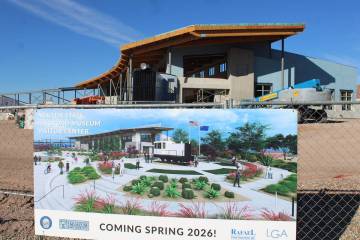State allocates funds for railroad visitors center
The Nevada State Railroad Museum received funding to develop cost estimates and designs for the new visitors’ center.
The state Interim Finance Committee allocated $469,000 for the museum.
More money is needed for the project that is estimated at $3 million to $5 million, but the earmark is a start that hopefully will draw in other support.
A plan for a visitors’ center has been in the works since 2002, but the country’s recession all but ended talks for it.
“This is not a new project, but with the economy taking a downturn we had to put the project on hold,” railroad museum director Randy Hees said. “Fortunately, for the first time in a long time, we are seeing the state feel comfortable with the economy and invest in new projects.”
One driving factor behind the state’s decision to fund the museum was an increase in tourism for the fiscal year that ended June 30. The state had a $2.5 million room tax surplus and decided to give some of that extra money to the railroad museum.
However, Peter Barton, Nevada Museums and History Division administrator, said the success of the railroad museum was also a factor.
“The museum has a … train ridership of 34,000 people a year, and 8,000 tourists a year come to look at the locomotives,” Barton said. “When we started this project we were conservative about its success, but the numbers improve significantly each year, and every program or event we do sells out. The facility needs to be improved, and it only makes sense to invest in a better experience for visitors.”
The new center would be located in the empty lot between Buchanan Boulevard and Nevada Highway. The new center would be a vast improvement from the current spot on Yucca Drive behind the Taco Bell, according to Hees.
“We are one of the most successful museums in the state, and we are running it out of a garden shed,” Hees said, referring to the 200-square-foot gift shop that serves as the museum’s central hub. “Right now all our locomotives are in an open atrium, which is something we want, but the plan has always been to have an indoor facility as well and it seems a bit more likely that it will happen.”
Hees and Barton would not give a definitive date for the construction because state funding only covers design plans. The rest of the money will more than likely have to come from the private sector, they said.
“No matter what money we get from the state the majority is going to have to come from the private sector,” Hees said. “The success of this project is going to depend on the public and the community in Boulder City.
Hees and Barton are seeking potential donors with the help of the Boulder City Chamber of Commerce and its CEO, Jill Rowland-Lagan.
“We are working hard to find the funding we need to make this project happen,” Rowland-Lagan said. “This is a complex project that is going to take hard work from the state and the communities in Boulder City and Henderson.”
Rowland-Lagan, Barton and Hees met with officials in Henderson last week to discuss their roles in the completion of the project. Rowland-Lagan said the meeting was productive and that Henderson officials were receptive to a partnership.
Those close to the project are focused on building the visitors’ center, but the organizations working on the project hope to eventually install a railroad path that would reach from the visitors center to the Water District in Henderson. Plans to interconnect the railroad route to parks such as the River Mountain Loop Trail with bike paths are in the works.
“One day we would really like to turn this project into a full experience that would serve as one of Boulder City’s central hubs,” Hees said. “Part of the creation of the (Interstate 11) bypass is the installation of a bridge that the railroad would go across. It will bring riders up Railroad Pass so they will be able to see the lights of Las Vegas.
The participation of Henderson is instrumental for the project to be a success, since the city owns the majority of the railroad route.
Hees said the center would serve as a counterweight to the economic effects of Interstate 11.
“The interstate is the driving force behind this project because it is a pro and a con,” Hees said. “On one hand we are going to have less traffic in Boulder City, meaning more tourists can get to the center without dealing with the traffic. But at the same time less traffic means less people driving through the town.”
Barton said the center can serve as a vitality boost against the negative side effects of the interstate.
“Boulder City needs this center,” Barton said. “We were funded in part because of the effects of the I-11 and the museum, which is already a proven success, creates a lot of new opportunities for the community to continue prospering.”
No definitive cost for the project has been created yet since part of the the design phase is creating an estimate, but Barton said he has seen some rough estimates that put the total cost up to $5 million.
The design phase is expected to take at least eight months and construction would take another two years if the center was approved, according to Barton.
“If we work aggressively I can see us getting this plan through in eight months and at least another two years before we can really start building, but I can’t really guarantee that time line right now.”
However neither Barton or Hess felt it was fair to talk about the price of the center until they have created a proper design plan.
The Boulder City Council has been supportive with Mayor Rod Woodbury and Councilman Cam Walker publicly stating that the project is a smart move for the city.
Hess and Rowland-Lagan have been giving the City Council updates on the project, but he could not confirm if the city would help finance the project.
Contact reporter Max Lancaster at mlancaster@bouldercityreview.com or at 702-586-9401. Follow him on Twitter @MLancasterBCR.
















